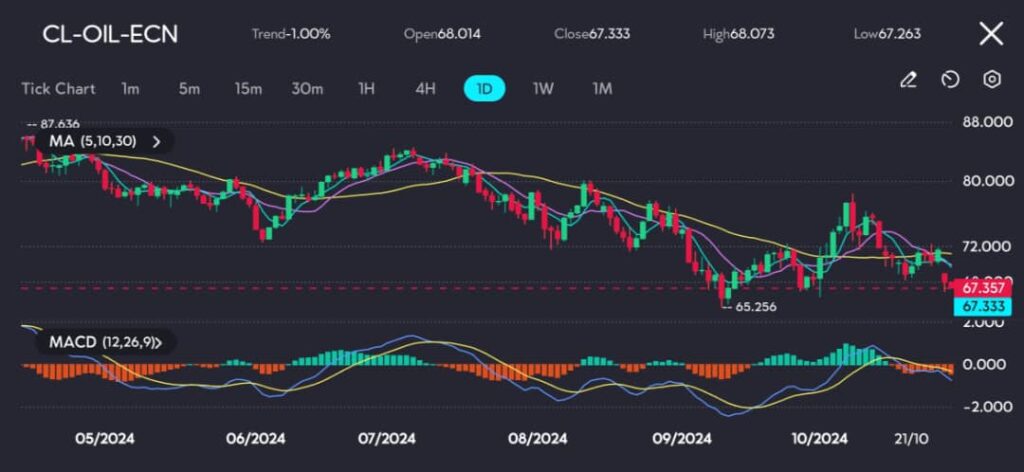Listen to the article here:
Key points:
- Brent crude rose 0.6% to $71.86, while WTI gained 0.7% to $67.83 following a 6% drop.
- U.S. strategic oil purchase plan offers support as Israel-Iran tensions loom over market sentiment.
Oil prices inched up on Tuesday, with Brent crude up 44 cents to $71.86 a barrel and WTI crude climbing 45 cents to $67.83 a barrel after Monday’s steep 6% drop.
The slide had marked the lowest point since October 1, spurred by rising tensions in the Middle East, as Israeli air strikes on Iran avoided targeting Tehran’s oil infrastructure.

See: WTI Oil may be attempting a rebound near support levels around $65, though the bearish MACD suggests recovery could be limited unless momentum shifts. Download the VT Markets app now.
Investors found renewed support on Tuesday, however, with the U.S. announcing plans to add up to 3 million barrels to its Strategic Petroleum Reserve (SPR), adding demand stability while geopolitical risks continued to influence sentiment.
U.S. Reserve Refill Signals Support for Oil Prices Amid Demand Concerns
The U.S. commitment to purchase these barrels signals an effort to shore up strategic reserves, though funding constraints could limit further purchases until additional congressional approval.
This reserve strategy highlights a supportive stance toward oil markets amid broader demand challenges. The purchasing timeline extends through May next year, which may provide a longer-term cushion for oil prices and indicate cautious optimism from the U.S. about reducing volatility in energy supply.
Israel-Iran Tensions Maintain Oil Market Uncertainty
The latest developments in Israel-Iran relations have kept the oil market on edge. On Saturday, Israeli jets conducted three waves of air strikes on sites near Tehran and western Iran, targeting missile facilities while leaving oil infrastructure intact.
This shift towards strategic military targets has temporarily reduced the risk of disruptions in oil flows.
Still, tensions remain high, especially after Iranian officials signalled on Monday that they could take further action in response to the strikes, adding potential pressure on oil supply in the future.
The U.S. has warned Iran of serious consequences if aggression continues, bringing uncertainty to the market outlook.
On the demand side, winter kerosene usage across the Northern Hemisphere remains limited as temperatures haven’t yet spiked, while China’s economic recovery continues to face challenges, resulting in subdued demand from the world’s largest oil importer.
Market participants are keeping a close watch on upcoming inventory data releases by the American Petroleum Institute and the Energy Information Administration.
Early reports suggest a potential increase in crude and gasoline stocks but a decrease in distillate inventories, potentially reflecting slight adjustments in fuel demand.
See also: Oil Dips as U.S. Crude Stocks Rise
With winter months still ahead and China’s recovery pace uncertain, any renewed geopolitical disruptions could reintroduce volatility.
Start trading now — click here to create your live VT Markets account.









